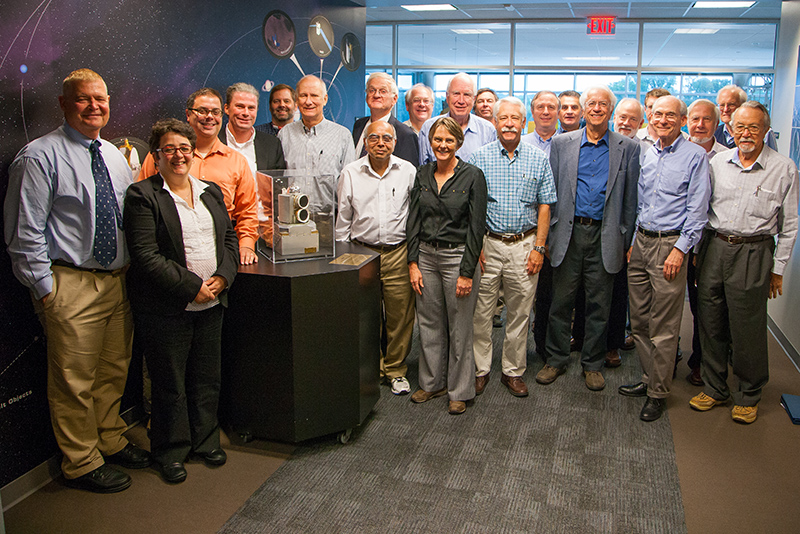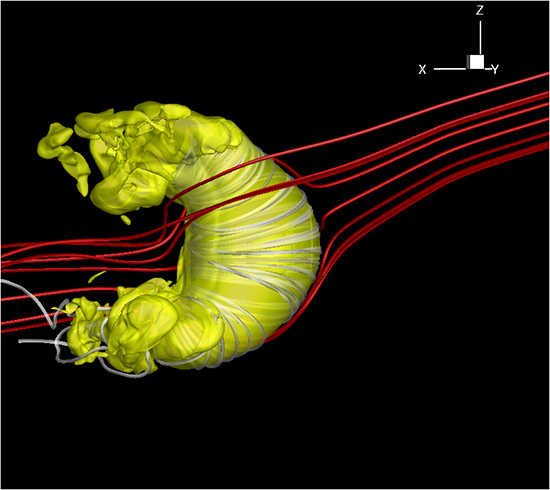New Vision of the Final Frontier
Astronomer boldly redraws boundary at solar system’s end

Women at the edge of STEM: Merav Opher, on the left, is the only female investigator on the Voyager team, shown here at a meeting in 2014. Suzanne R. Dodd, in middle, is program manager. Photo courtesy of Johns Hopkins University Applied Physics Laboratory
Merav Opher isn’t afraid of boundaries.
In a field dominated by men years her senior, she has navigated age and gender barriers to become an associate professor of astronomy at Boston University’s College of Arts & Sciences, director of BU’s Center for Space Physics, and the only female investigator on NASA’s Voyager spacecraft mission. Now, she’s aiming at a boundary so distant that no living person will ever cross it: the boundary at the end of our solar system.
She is proposing a radical rethinking of that final frontier—an area called the heliosphere—that challenges long-held scientific assumptions about our universe. Opher and co-author James Drake, a physics professor at the University of Maryland, published these new findings in February in The Astrophysical Journal Letters. The sophisticated computer model, which they developed with study co-authors Bertalan Zieger, a research scientist at BU’s Center for Space Physics, and Tamas Gombosi, a professor of space science at the University of Michigan, could provide scientists with a powerful new tool for studying the streams of particles, known as astrophysical jets, emanating from many other stars and around black holes. Their research, which is funded by NASA, may lead to a better understanding of the way other star systems in the universe work.
As the sun moves through the galaxy, it sends out charged particles in a stream of plasma called the solar wind. The solar wind creates the area beyond the solar system that is the heliosphere. One of two identical spacecraft launched in 1977, Voyager 1 in 2012 became the first man-made object to exit the heliosphere and plunge into “the beyond”—the vast, all-but-empty void between the stars that is known as interstellar space.
For decades, scientists have visualized our heliosphere as shaped like a comet, with one very long tail extending thousands of times further than the distance from the Earth to the sun. Opher and Drake are suggesting that the heliosphere’s classic comet tail is actually two jets of accelerated compressed plasma, similar in format to the astrophysical jets observed around other stars. They stumbled upon their discovery as they were studying Voyager 1 data to try to understand how the galaxy’s magnetic field interacts with the heliosphere.
“It’s super cool,” Opher says. “The heliosphere is our home. It’s where we live. Can you imagine you’re sitting in your house and suddenly you found out there were two gigantic hoses coming out of the back of your house and air that is inside your house is coming out of them? We’re realizing that even the basic structure of our home is different from what we thought.”

At the heart of the heliosphere, encircling the sun, is a region called the termination shock, where the solar wind abruptly slows down like traffic approaching a toll plaza. Beyond the termination shock is the heliosheath, where the solar wind becomes dense, slow, and turbulent. Even further out, at a point called the heliopause, the pressure inside the heliosphere balances with the pressure outside; this is the outer wall of the heliosphere.
If this seems complicated, hang on to your hat: It’s about to get even more so. Because the sun and the solar system are moving relative to the surrounding interstellar medium, the heliosphere is not actually a sphere. It has a blunt nose on one side, where it butts up against the interstellar medium, and is elongated on the other. Astronomers and space physicists used analytical models to arrive at their view that the far end of the heliosphere fades out in a long comet tail.
Though astronomers have observed analogous structures around other stars, where they are termed astrospheres, mapping our own heliosphere is a major observational challenge. The problem: The heliosphere is invisible. It does not emit its own light. How do you observe something you can’t see? Astronomers have come up with clever ways to “feel” out its confines, using measurements from spacecraft like the Voyagers, which are encountering particles firsthand in the solar system’s furthest reaches. Scientists are also gaining insight into the heliosphere from NASA’s Interstellar Boundary Explorer and Cassini missions, which pick up traces of energetic neutral atoms produced where particles from the solar wind and interstellar medium meet.
“Before the Voyager spacecraft, we had these cartoons,” says Opher, describing space physicists’ rough visualizations of the shape of the heliosphere. “We did not have in situ measurements.” Voyager 1 and 2 changed all that when, after almost three decades in space, they began probing the region near the heliosheath. (Voyager 1 entered the heliosheath in 2004; Voyager 2 followed in 2007.) “Immediately, it became crazy!” recalls Opher. The data coming in from the Voyagers did not match up with the placid environment predicted by the conventional cartoon image.
Opher and Drake’s new model, based on computer code developed by space physicists at the University of Michigan, plays out the interaction of hydrogen atoms from the solar wind and interstellar medium under the influence of magnetic fields from both the interstellar medium and the sun. Thanks to rapid advances in computing power, Opher could perform the three-dimensional simulation at extremely high resolution. “A couple of years ago, it would not have been possible” to create such a detailed simulation, says Opher.

Opher’s simulation was different in another way, too. In the past, many researchers ignored the influence of the sun’s magnetic field, which is complicated to model and was assumed to be of negligible impact. In fact, the pressure due to the sun’s magnetic field is as little as a tenth of that from the thermal energy of the particles in the heliosheath, explains Opher, which seemed like “a great reason to throw it under the carpet!”
Those who did try to account for the sun’s magnetic field typically modeled it with its northern and southern hemispheres spiraling in opposite directions. That detail, while true to the sun’s real magnetic field, caused a snag in the simulations that artificially weakened the field. To avoid that problem, Opher and Drake swapped out the double-spiral field, called a “dipole,” for a single spiral, or “monopole,” field, which is a good approximation for the shape and intensity of the magnetic field, says Opher.
The result was a shock: Instead of a comet tail, the simulation generated something that looked more like a bent Slinky®, says Opher. “I was stunned!” she recalls. “How had we not noticed it before?”
The problem, says Opher, wasn’t just that simulations failed to produce the jet structure, but that most scientists assumed that the flow of charged particles within the heliosheath would be strong enough to overpower the sun’s weak magnetic field. However, says Opher, “Magnetic fields don’t like to be stretched. They are like rubber bands; they will push back.” To Opher’s astonishment, this “magnetic tension” turns out to be strong enough to confine the particles in the heliosheath and force them out into two powerful jets.
Drake, who is co-director of the Joint Space-Science Institute at the University of Maryland, compares the effect to squeezing a tube of toothpaste. “Imagine you wrap your toothpaste tube with a lot of rubber bands very tightly,” says Drake, explaining that the rubber bands represent the ring-shaped magnetic field produced by the sun. “You’re going to squeeze the toothpaste out the end of your tube.” In the case of the heliosphere, though, the toothpaste is squeezed out of both ends of the tube—and the toothpaste is actually solar plasma, which gets “squeezed” into jets by the sun’s magnetic field.
The heliosphere jets look like baby versions of the super-powered jets that exist around exotic objects like black holes and pulsars, Opher and Drake write in their paper. They say they hope that the heliosphere jets can provide astrophysicists with a homegrown laboratory in which to study their more distant, energetic cousins. “If we’re right about all of this, it gives us a local test bed for exploring some very important physics,” says Drake.
Opher expects the new model to be controversial. “This is going to be heavily, heavily debated,” she says, pointing out that many scientists in the field have spent long and distinguished careers working from the traditional “comet” model of the heliosphere. But, says Opher, the “out-of-the-box” results coming from spacecraft observations demand a similarly unconventional explanation.
This isn’t the first time Opher has championed an unexpected—and bound to be contentious— result. In 2011, she and Drake suggested that the heliosheath is roiling with magnetic bubbles, challenging an earlier, more tranquil view of the region. The “foam versus no-foam” debate still rages among astrophysicists.
Additional data on the heliosphere’s boundaries will become available sometime in the next few years when Voyager 2, like its twin, crosses into interstellar space. “I’m sure there will be more surprises,” Opher says. “We keep discovering new things.”
For previous coverage of Merav Opher, with video, click here.
Comments & Discussion
Boston University moderates comments to facilitate an informed, substantive, civil conversation. Abusive, profane, self-promotional, misleading, incoherent or off-topic comments will be rejected. Moderators are staffed during regular business hours (EST) and can only accept comments written in English. Statistics or facts must include a citation or a link to the citation.